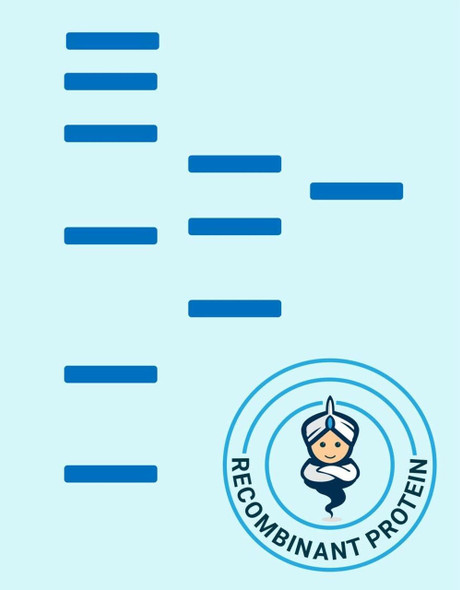Human LDLRAP1 Recombinant Protein (RPPB3852)
- SKU:
- RPPB3852
- Product Type:
- Recombinant Protein
- Species:
- Human
- Uniprot:
- Q5SW96
Description
| Product Name: | Human LDLRAP1 Recombinant Protein |
| Product Code: | RPPB3852 |
| Size: | 20µg |
| Species: | Human |
| Target: | LDLRAP1 |
| Synonyms: | Low density lipoprotein receptor adaptor protein 1, Autosomal recessive hypercholesterolemia protein, ARH1, FHCB1, FHCB2, ARH2, LDL receptor adaptor protein, MGC34705, DKFZp586D0624. |
| Source: | Escherichia Coli |
| Physical Appearance: | Sterile Filtered colorless solution. |
| Formulation: | The LDLRAP1 solution (0.5mg/ml) contains 20mM Tris-HCl buffer (pH 8.0), 200mM NaCl, 2mM DTT and 10% glycerol. |
| Stability: | Store at 4°C if entire vial will be used within 2-4 weeks. Store, frozen at -20°C for longer periods of time. For long term storage it is recommended to add a carrier protein (0.1% HSA or BSA).Avoid multiple freeze-thaw cycles. |
| Purity: | Greater than 90% as determined by SDS-PAGE. |
| Amino Acid Sequence: | MGSSHHHHHH SSGLVPRGSH MDALKSAGRA LIRSPSLAKQ SWGGGGRHRK LPENWTDTRE TLLEGMLFSL KYLGMTLVEQ PKGEELSAAA IKRIVATAKA SGKKLQKVTL KVSPRGIILT DNLTNQLIEN VSIYRISYCT ADKMHDKVFA YIAQSQHNQS LECHAFLCTK RKMAQAVTLT VAQAFKVAFE FWQVSKEEKE KRDKASQEGG DVLGARQDCT PPLKSLVATG NLLDLEETAK APLSTVSANT TNMDEVPRPQ ALSGSSVVWE LDDGLDEAFS RLAQSRTNPQ VLDTGLTAQD MHYAQCLSPV DWDKPDSSGT EQDDLFSF |
LDLRAP1 is a cytosolic protein that holds a phosphotyrosine binding (PTD) domain and performing as a cytosolic adaptor it couples LDLR to endocytic machinery. Mutations in LDLRAP1 are the reason for autosomal recessive hypercholesterolemia (ARH) which is a condition triggered by defective internalization of LDL receptors (LDLR) in the liver.
LDLRAP1 Human Recombinant produced in E.coli is a single, non-glycosylated polypeptide chain containing 328 amino acids (1-308) and having a molecular mass of 36.1kDa.LDLRAP1 is fused to a 20 amino acid His-tag at N-terminus & purified by proprietary chromatographic techniques.
| UniProt Protein Function: | LDLRAP1: Adapter protein (clathrin-associated sorting protein (CLASP)) required for efficient endocytosis of the LDL receptor (LDLR) in polarized cells such as hepatocytes and lymphocytes, but not in non-polarized cells (fibroblasts). May be required for LDL binding and internalization but not for receptor clustering in coated pits. May facilitate the endocytocis of LDLR and LDLR-LDL complexes from coated pits by stabilizing the interaction between the receptor and the structural components of the pits. May also be involved in the internalization of other LDLR family members. Binds to phosphoinositides, which regulate clathrin bud assembly at the cell surface. Defects in LDLRAP1 are the cause of autosomal recessive hypercholesterolemia (ARH). ARH is a disorder caused by defective internalization of LDL receptors (LDLR) in the liver. ARH has the clinical features of familial hypercholesterolemia (FH) homozygotes, including severely elevated plasma LDL cholesterol, tuberous and tendon xanthomata, and premature atherosclerosis. LDL receptor (LDLR) activity measured in skin fibroblasts is normal, as the LDL binding ability. |
| UniProt Protein Details: | Chromosomal Location of Human Ortholog: 1p36.11 Cellular Component: recycling endosome; internal side of plasma membrane; AP-1 adaptor complex; axon; early endosome; neurofilament; basal plasma membrane; AP-2 adaptor complex; cytosol Molecular Function:phosphatidylinositol-4,5-bisphosphate binding; protein binding; clathrin binding; receptor signaling complex scaffold activity; low-density lipoprotein receptor binding; phosphotyrosine binding; beta-amyloid binding Biological Process: cholesterol metabolic process; receptor-mediated endocytosis; cholesterol homeostasis; positive regulation of signal transduction; transport; amyloid precursor protein metabolic process; regulation of protein binding; receptor internalization; positive regulation of receptor-mediated endocytosis Disease: Hypercholesterolemia, Autosomal Recessive |
| NCBI Summary: | The protein encoded by this gene is a cytosolic protein which contains a phosphotyrosine binding (PTD) domain. The PTD domain has been found to interact with the cytoplasmic tail of the LDL receptor. Mutations in this gene lead to LDL receptor malfunction and cause the disorder autosomal recessive hypercholesterolaemia. [provided by RefSeq, Jul 2008] |
| UniProt Code: | Q5SW96 |
| NCBI GenInfo Identifier: | 116241254 |
| NCBI Gene ID: | 26119 |
| NCBI Accession: | Q5SW96.3 |
| UniProt Related Accession: | Q5SW96 |
| Molecular Weight: | |
| NCBI Full Name: | Low density lipoprotein receptor adapter protein 1 |
| NCBI Synonym Full Names: | low density lipoprotein receptor adaptor protein 1 |
| NCBI Official Symbol: | LDLRAP1�� |
| NCBI Official Synonym Symbols: | ARH; ARH1; ARH2; FHCB1; FHCB2; FHCL4�� |
| NCBI Protein Information: | low density lipoprotein receptor adapter protein 1 |
| UniProt Protein Name: | Low density lipoprotein receptor adapter protein 1 |
| UniProt Synonym Protein Names: | Autosomal recessive hypercholesterolemia protein |
| UniProt Gene Name: | LDLRAP1�� |
| UniProt Entry Name: | ARH_HUMAN |










